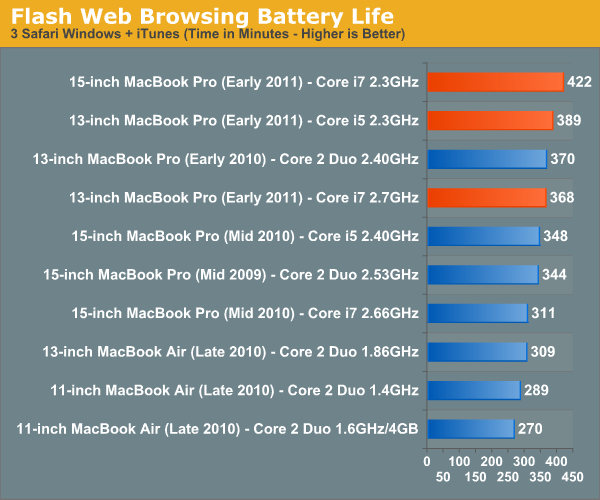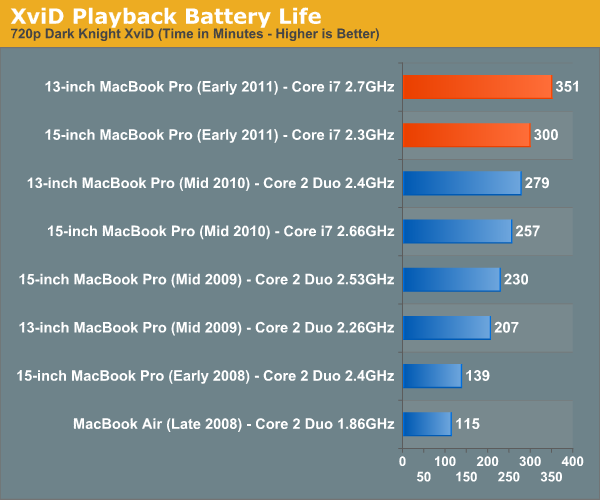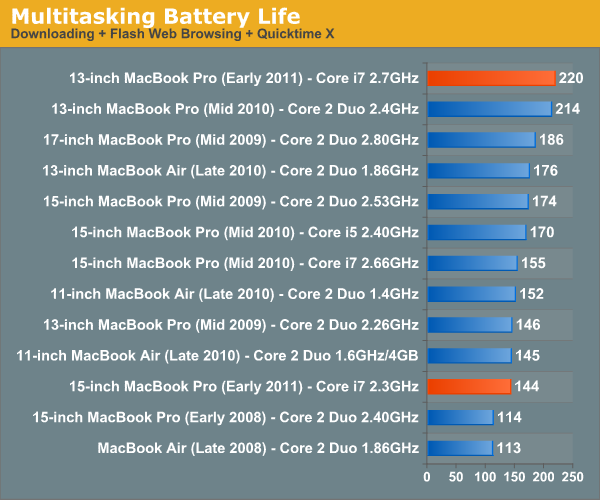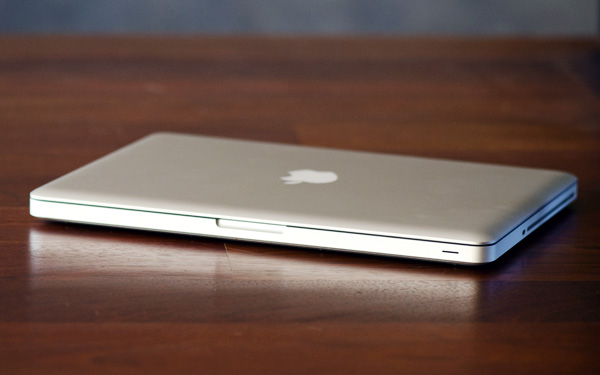The MacBook Pro Review (13 & 15-inch): 2011 Brings Sandy Bridge
by Anand Lal Shimpi, Brian Klug & Vivek Gowri on March 10, 2011 4:17 PM EST- Posted in
- Laptops
- Mac
- Apple
- Intel
- MacBook Pro
- Sandy Bridge
Battery Life
With the potential for higher power draw, battery life on these new systems has the chance to be really, really bad. In reality it breaks down like this: light usage cases are equal if not better than last year's model. Apple makes up for the higher core count of the 15-inch MBP by capping turbo speeds and being very good about allowing the CPU to go into deep sleep states under OS X. On top of that, Sandy Bridge is a very efficient microarchitecture that manages to get work done quicker than Arrandale and get to sleep faster.
Heavy usage cases however can easily be worse than last year's model, specifically with the 15 and 17-inch systems. The new 13 is a mixed bag. Core 2 was a pretty low power architecture, beating its battery life will be difficult. The only scenario our battery life tests don't duplicate is one where workload scales with performance. Right now all of our tests are fixed workloads: web pages may render quicker, but you'll still be idle for the same amount of time regardless of system. Video frames may decode quicker, but they'll still play back at the same 24 fps. If you use the additional performance of these systems to do more then you'll likely see even worse battery life (see the power numbers on the previous page).
Light Web Browsing
Here we're simply listing to MP3s in iTunes on repeat while browsing through a series of webpages with no flash on them. Each page forwards on to the next in the series after 20 seconds.
The display is kept at 50% brightness, all screen savers are disabled, but the hard drive is allowed to go to sleep if there's no disk activity. The wireless connection is enabled and connected to a local access point less than 20 feet away. This test represents the longest battery life you can achieve on the platform while doing minimal work. The results here are comparable to what you'd see typing a document in TextEdit or reading documents.

For the 15-inch model battery life has doubled since 2008. Even compared to last year's model Apple has actually improved idle/light usage battery life by 8%. With 9 hours of battery life I can confirm that if you're just using the 15-inch MBP as a glorified typewriter this is what you'll see. It's a great combination of a system that has performance on tap but the battery life to last you if you just need to do some writing.
The 13-inch MacBook Pro actually takes a step back compared to last year's model but it's still the Mac with the 3rd longest battery life.
Boot Camp Battery Life
Under Windows 7 there's no option to use the iGPU, the 15 and 17-inch MacBook Pros default to their dGPU. As we already showed, simply enabling the dGPU hurts battery life. What about the move to Windows 7 on top of that? To find out I ran our light web browsing battery life test under Windows 7. I subbed in IE8 and Windows Media Player for Safari and iTunes and otherwise ran with similar settings as our Mac test:

Compared to OS X with the dGPU enabled, Windows 7 delivers 20% lower battery life. The bigger penalty however is the forced dGPU usage under Windows. If you're planning on using the new 15-inch MBP as a Windows notebook, don't expect to get anywhere near the battery life that is promised under OS X.
Flash Web Browsing
The test here has three Safari windows open, each browsing a set of web pages with between 1—4 animated flash ads per page, at the same time. Each page forwards onto the next after about 20 seconds.
As always, the display is set to 50% brightness, audio at two bars, screensaver disabled and the hard drive is allowed to go to sleep if idle. The wireless connection is enabled and connected to a local access point less than 20 feet away.

Turn Flash on and up the intensity of the workload and the numbers get a lot more reasonable. The new 15-inch MacBook Pro leads the pack with 7 hours of battery life. You'll note that this is exactly what Apple promises on its website. At 7 hours this is also a 20% improvement over last year's model. Other than OS/optimization differences the only explanation I have here is that Sandy Bridge provides a sufficient enough increase in CPU performance to render a page and flash ads get to sleep quicker compared to Arrandale. Another contributing factor is the new 32nm iGPU which is active full-time under Safari. The GPU alone is probably a bit more efficient at rendering flash than last year's GeForce GT 330M.
The 13-inch model actually equals its predecessor. I suspect the Core 2 Duo is still a lower power CPU under a moderate load.
XviD Video Playback
I ripped The Dark Knight to XviD and played it back continuously in QuickTime X with Perian installed. For this test the display was set to full brightess and audio was set at two bars below maximum. Once more the hard drive was allowed to go to sleep if it was idle. The AirPort (wireless LAN) was enabled and connected to a local access point less than 20 feet away.

Multitasking Battery Life
Our final battery life test is the worst case scenario. In this test we have three open Safari windows, each browsing a set of web pages with between 1—4 flash ads per page, at the same time. We're also playing an XviD video in a window all while downloading files from a server at approximately 500KB/s.

I mentioned earlier that the new 15-inch MBP has the potential to have much worse battery life given that it has twice the cores of its predecessor. Our multitasking battery life test gives you a little indication of that. At 144 minutes the new 15 lasts just under 2.5 hours here. It's only a slight reduction compared to last year's model but that's only because the workload isn't scaled up at all. OS X is likely scheduling work here across all four cores rather than just two in last year's model, driving up power consumption and decreasing battery life ever so slightly.
The new 13-inch on the other hand is pretty sweet. At 3.66 hours it's the new king of our multitasking battery life test, and it's even a slight improvement compared to the 2010 version.
Just playing back movies on the new SNB notebooks is an improvement on both models. The new 15 manages 5 hours while the new 13 is good for almost 6 hours of battery life.
Overall I'd say the battery life story of the new MacBook Pros is a mixed bag. Under light to moderate workloads the 15-inch will likely do better than the 2010 15-inch MBP, while the 13-inch is roughly the same as its predecessor. It's only under heavy use that the new 15-inch will actually do worse than last year's model. You will have to keep an eye on what you're doing with the machine because the new 15-inch MBP has the ability to use a lot more power than last year's model. The bigger issue actually has to do with the dGPU. If you use Chrome or any of the other applications that will trigger the dGPU to turn on, kiss your battery life goodbye. Even light usage suffers if your discrete GPU is active.
The new 13 is a bit less finicky. It's either going to offer you similar or better battery life than last year's model.











198 Comments
View All Comments
dqnet - Wednesday, March 16, 2011 - link
I'm really considering splashing out on the 13" but I've read countless articles and all I hear is the glossy screen is either horrible or awful. I don’t want the 15", I need the portability and I don’t know what on earth to do!??????????Then comes the SSD issue, if I want this option I have to wait 6 weeks!
I can always get this later down the line I guess?? Well from what the article suggests??
Any help (opinions) would be great as right now I’m lost! :(
Mac Ike - Wednesday, March 16, 2011 - link
If a person bought a MacBook Pro in the last 18-24 months,I don't see the reason to upgrade unless you're on the Bleeding-edge of performance needs and Mac your living with your Mac. Many Apps and advanced Software aren't even optimized to take advantage of multiple Cores,or Hyper-Threading/Turbo Boost. I don't care as much for Auto Switching Graphics,since I have total control of my Graphics with my March 2010 MacBook Pro 17"/Core 2 Duo/2.8 Ghz/4GB RAM/AG/500GB HD/512MB or 256(IG) VRAM-dual cards/express card. if I was buying new today,Hyper-Threading and Turbo Boost schemes would be OK,but there's no way that I'd trade or sell my machine for these updates! To me,speed hasn't been an issue in 2 or 3 years! My 2006 20" iMac was at 2.0 Ghz,and the newest Macs are 2.0-3.0Ghz or so. I know that Sandy Bridge is faster than a Merom Core Duo,but most improvements seem to have come from adding more Cores and RAM,so that more tasks can be done simultaneously! I don't care for gimmicks,Turbo-Boosting,Hyper-Threading,and poorer graphics to convince me to upgrade my Macs. Unless you are a Digital Video Content Creator,or other high-powered user,or your Mac is 3 yrs. Old or so,you should Max-out your RAM,get a faster HDD or an SSD,rather than buying a Whole New Mac! If you have the money to spend,good for you,but a combination of Power,Battery-Life,and Portability,are the REAL issues! I wish people would stop telling others that they're Idiots for paying Mac prices,since it's our Money,and only YOU can determine what's good value for the Performance,elegance,and Stability of Apple Hardware!rredge - Thursday, March 17, 2011 - link
Today, the local Apple store acknowledged that my 15" MacBook Pro is not functioning properly and refunded the purchase price despite the fact that I was just past the 14 day return period.The problem is that the computer ceased to respond to the trackpad even when rebooted with the power button.
In the course of trying to figure out what the problem was, I discovered that there are reports of people experiencing similar problems for all three models (13", 15", 17") on Apple's support forum, where one thread alone now runs 19 pages, as well as elsewhere on the internet.
The Apple store personnel told me that Apple has not acknowledged that there is a problem with this line of computers, although they acknowledged in less than two minutes that my computer has a problem sufficiently serious to warrant a refund out of the return period. I declined a replacement because they expressed ignorance of the issue, indeed said that Apple did not acknowledge an issue, and were unable to give me any assurance that a replacement would perform any better.
The questions at this point are how widespread this freezing problem is and whether Apple is going to acknowledge it and fix it.
rredge - Thursday, March 17, 2011 - link
The second paragraph should have said that the computer ceased to respond to both the trackpad and keyboard.nitrousninja - Thursday, March 17, 2011 - link
I saw the benches but I dont know if that translates into a big real world difference in SSDs. I'm mostly doing stuff in Word/Excel, some light video editing/converting, and occasionally some WoW. This would be in the base model 13"Should i go with the stock 3GB 128GB SSD or the OCZ 6GB I can get at Microcenter and install it mysel?. I've never done that on a Mac.
Thanks for the help!
Matt
tno - Wednesday, May 4, 2011 - link
Doubt you're still wondering but, if you want to have any space left after installing an OS and still want an SSD then you should splash for the 128GB SSD or wait till a reliable larger SSD is available. I wouldn't go less than 120GB.As to whether you should get an SSD, just ask yourself this question:
Have you ever sat, even for a moment, and wondered why an otherwise well specced (but magnetically driven) computer seemed slow?
If yes, then you'll likely be able to set that question aside by putting in an SSD.
tranksen76 - Friday, March 18, 2011 - link
Hello Rredge,how frustrating your experience sounds!
2011 was the year I was finally supposed to buy myself my 1st ever MBP after 18 years in the Windows environment.
It took me long enough to choose between a 13-inch or 15-inch one but then I started reading about these freeze issues a lot of users have been facing. being French i only heard about this problem within French forums and i was hoping this would have to be a specific problem for a batch of units delivered in France but now I have to admit this really is a larger scope problem.
For what it's worth there were comments on the forums I went through about I-Stats being a cause for these problems as it installs by default with a settings that take over the fans control.
Did you have that app on your computer?
Best regards
Tranksen
rredge - Friday, March 18, 2011 - link
Bonjour Tranksen,The fan on my computer was acting normally when this happened and I do not have that widget installed. I was running Terminal, TextEdit and Safari and the processor was under extremely light load.
You will find a good deal of discussion about this problem on the Apple U.S. support forum at http://discussions.apple.com/category.jspa?categor...
This is not an imaginary issue. Apple agreed to the return of my computer for full refund despite it being outside the 14 return period.
I would consider repurchasing one of these computers, but not until Apple clarifies what the problem is and fixes it.
tipoo - Saturday, March 19, 2011 - link
You said that noise was an issue with the larger MPB, but I'd like that to be quantified in decibels and compared to other laptops in a table, in future reviews.Omid.M - Monday, March 21, 2011 - link
Can the AT team comment on this please:http://apple.slashdot.org/submission/1504006/2011-...
Click on "Link to Original Source"
Can you guys duplicate this issue? Is it just simple overheating and poor design on Apple's part? I really want to know...
Also tweeted to the three of you. Thanks for your thoroughness, gang.